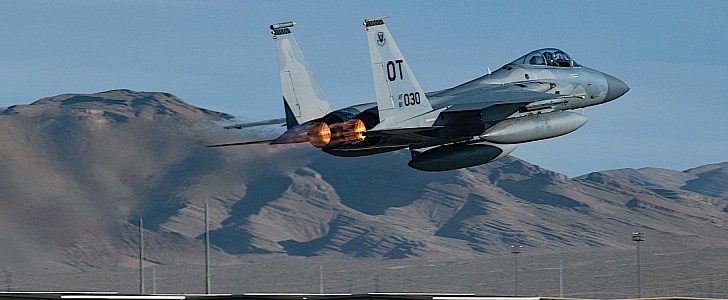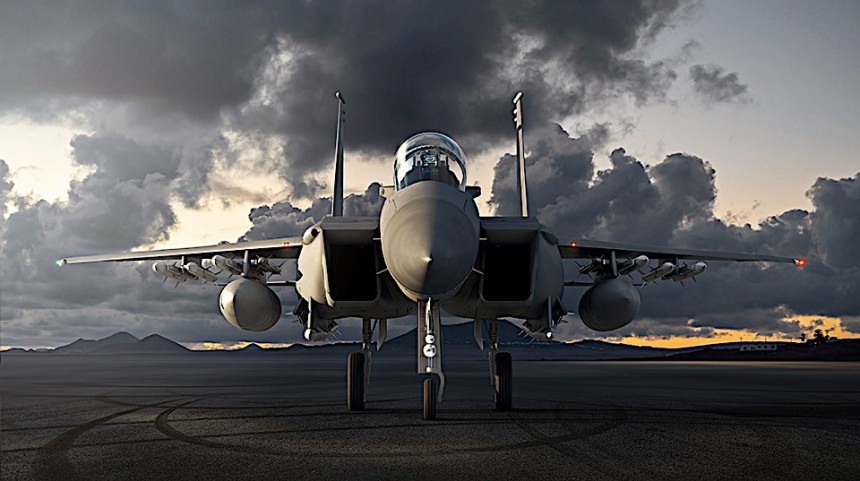What is there that can be said about the Boeing-McDonell Douglas F-15 Eagle that hasn't already been said? It's beloved the world over by Air Forces and regular civilians who grew up with the prized American fighter jet as a pin-up poster darling.
Believe it or not, it's been exactly 50 years since the burley American twin-engine fighter jet first took to the air. In that time, it's established a combat record so flawless, so impeccable, and so astonishingly clean that no fighter made before or since even comes close. Today, let's take a deep dive back into the origins and the illustrious career of the almighty Eagle, America's most successful modern fighter.
In truth, the origins of the F-15 program date back before the early 1970s. In the mid-1960s and through the Vietnam War, the United States Air Force relied heavily on jet fighters designed in the 1950s. Fighters like the North American F-100 Super Saber, the Republic F-105 Thunderchief, and the McDonnell-Douglas F-4 Phantom II.
Out were the days of raw, straight-line speed and a lack of emphasis on dogfighting of the previous decade. In its place was a philosophy of building the world's most capable, maneuverable, and powerful air-superiority fighter. Capable of all the things previous generations of American fighter jets could do but also so much more.
Even before the last American helicopter made its way out of Saigon, there was an airplane undergoing testing that promised to address all of these concerns. The jet in question was the very first F-15A Eagle to fly back on 27 July 1972.
The Eagle was rare among its contemporaries, as it completely skipped having a YF designation added to its name during early flight testing. It, along with the Grumman F-14 Tomcat, are two of the few American fighters with this distinction.
With two powerful Pratt & Whitney F100-PW-220 after-burning turbofans on offer in the upgraded F-15C Eagle, the jet could blitz past twice the speed of sound at high altitude and even maintain supersonic down at sea level. Combine this with a slew of AIM-7 Sparrow, AIM-9 Sidewinder, and AIM-120 AMRAAM air-to-air missiles at its disposal, and no wonder the Eagle racked up a record of over 100 enemy aircraft shot down without so much as a single loss.
Keep in mind that's without mentioning the 20 mm M61 Vulcan autocannon for added fun. Of these shootdowns, over half were performed by the Israeli Air Self Defense Force. Be it in U.S. Service, Saudia Arabia, Japan, or Israel, the F-15's shined like a diamond wherever it's served. Granted, as many as 175 F-15s have been lost over the years to non-combat incidents. But not a single one involved a missile or bullet being fired.
Even with this being the case, that's an awe-inspiring service record. That's without even including the exploits of the multirole upgrade path for the Eagle, the F-15E Strike Eagle, which first flew in the late 1980s. Overall, the F-15 is one of the finest fighter planes ever to fly. That's why even as the F-22 Raptor and F-35 Lightning II continue to receive most of the media attention, militaries across the globe are still all too hesitant to give up their prized Eagles. That alone should speak volumes.
In truth, the origins of the F-15 program date back before the early 1970s. In the mid-1960s and through the Vietnam War, the United States Air Force relied heavily on jet fighters designed in the 1950s. Fighters like the North American F-100 Super Saber, the Republic F-105 Thunderchief, and the McDonnell-Douglas F-4 Phantom II.
Though all of there were supremely powerful, capable, and adaptable jets, they all fell victim more often than not to smaller, lighter, and more maneuverable Soviet jets. Fighters like the MiG-17, MiG-19, and the MiG-21 routinely gave U.S. Air Force, Navy, and Marine Corps pilots all the hell they could handle. Though some dogfights turned out favorably for American fighters, a fair amount did not.
The prospects of great swaths of American pilots floating down over enemy territory with their airplanes spiraling out of the sky on fire was one the Pentagon surely wanted to put behind them. Upon the conclusion of the Vietnam War, it was clear a new strategy was needed for American fighter jets.
The Eagle was rare among its contemporaries, as it completely skipped having a YF designation added to its name during early flight testing. It, along with the Grumman F-14 Tomcat, are two of the few American fighters with this distinction.
With two powerful Pratt & Whitney F100-PW-220 after-burning turbofans on offer in the upgraded F-15C Eagle, the jet could blitz past twice the speed of sound at high altitude and even maintain supersonic down at sea level. Combine this with a slew of AIM-7 Sparrow, AIM-9 Sidewinder, and AIM-120 AMRAAM air-to-air missiles at its disposal, and no wonder the Eagle racked up a record of over 100 enemy aircraft shot down without so much as a single loss.
Even with this being the case, that's an awe-inspiring service record. That's without even including the exploits of the multirole upgrade path for the Eagle, the F-15E Strike Eagle, which first flew in the late 1980s. Overall, the F-15 is one of the finest fighter planes ever to fly. That's why even as the F-22 Raptor and F-35 Lightning II continue to receive most of the media attention, militaries across the globe are still all too hesitant to give up their prized Eagles. That alone should speak volumes.






























